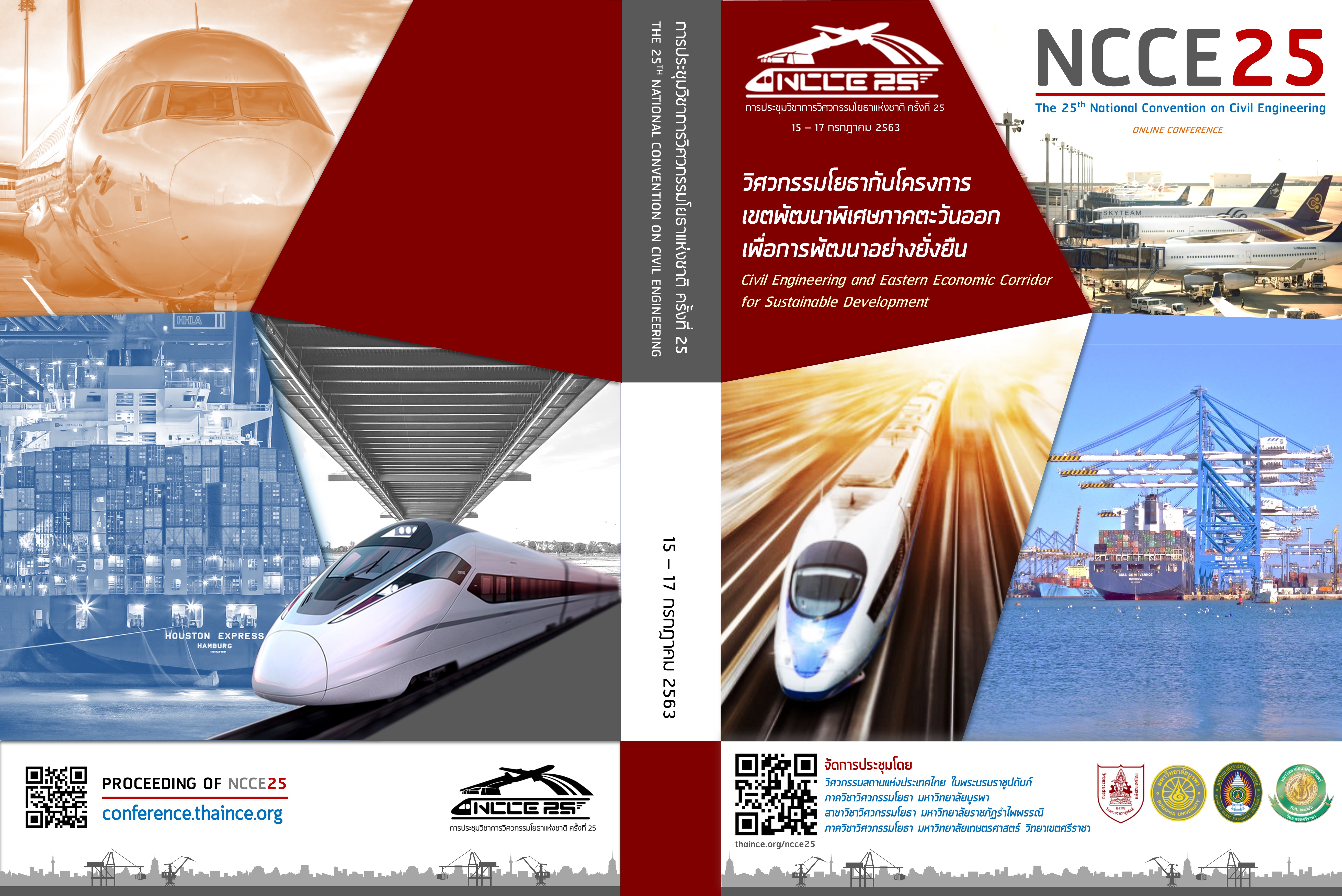กำลังดัดของคานคอนกรีตเสริมเหล็กที่ผสมเส้นใยเหล็กภายใต้สิ่งแวดล้อมคลอไรด์แบบวัฏจักรเปียกสลับแห้ง
Keywords:
คอนกรีต, เส้นใยเหล็ก, คานคอนกรีตเสริมเหล้ก, คลอไรด์, กำลังดัดAbstract
This paper aims to study the flexural strength of reinforced concrete (RC) beam containing steel fiber under chloride environment with cyclic wetting and drying. The compressive strength, splitting tensile strength of concrete containing steel fiber were also studied. Steel fiber was used at the content of 0.50% by volume of the concrete. The compressive strength and splitting tensile strength and were tested at the age of 28 days. The flexural strength test of the RC beam was done after the cyclic wetting and drying period of 2 years in the 5.0% of chloride solution. From the experimental results, it was found that the compressive strength of concrete containing steel fiber was similar to control concrete. The splitting tensile strength of concrete mixed with steel fiber was higher than that without steel fiber. The flexural strength of RC beam with steel fiber was higher than that without steel fiber. The flexural strength of RC beam exposed to chloride environment was lower than that exposed to the water.
Downloads
References
[2] Lan, L. (2014). A new experimental study on the basic mechanical properties of concrete, Dalian University of Technology, Dalian, China, 2014.
[3] Mohammed, T. J., Bakar, B. A. and Bunnori, N. M. (2016). Torsional improvement of reinforced concrete beams using ultra highperformance fiber reinforced concrete (UHPFC) jackets–experimental study. Construction and Building Materials, 106, pp. 533–542.
[4] Ya-Mei, H. and Li-Hua, W. (2018). Study on mechanical properties of green concrete. China Rural Water and Hydropower, 1, pp. 150–153.
[5] Zhang, P., Zhao, Y.-N., Li, Q.-F., Zhang, T.-H. and Wang, P. (2014). Mechanical properties of fly ash concrete composites reinforced with nano-SiO2 and steel fiber. Current Science, 106(11), pp. 1529–1537.
[6] Jaivignesh, B. and Sofi, A. (2017). Study on mechanical properties of concrete using plastic waste as an aggregate. Earth and Environmental Science, 80(1).
[7] Akca, A. H. and Ozyurt, N. (2018). Effects of re-curing on residual mechanical properties of concrete after high temperature exposure. Construction and Building Materials, 159, pp. 540–552.
[8] คณะอนุกรรมการคอนกรีตและวัสดุ วิศวกรรมสถานแห่งประเทศไทยในพระบรมราชูปถัมภ์., การเกิดสนิมของเหล็กเสริมในคอนกรีต. ความคงทนของคอนกรีต :30
[9] ASTM C39 (2004). Standard test method for compressive strength of cylindrical concrete specimens. Annual Book of ASTM Standard, 04.02.
[10] ASTM C496 (2004). Standard test method for splitting tensile strength of cylindrical concrete specimens. Annual Book of ASTM Standard, 04.02.
[11] ASTM C78 (2004). Standard test method for flexural strength of concrete (using simple beam with third-point loading). Annual Book of ASTM Standard, 04.02.
[12] Zheng, Y., Wu, X., He, G., Shang, Q., Xu, J., & Sun, Y. (2018). Mechanical properties of steel fiber-reinforced concrete by vibratory mixing technology. Advances in Civil Engineering, pp. 1–11.
Downloads
Published
How to Cite
Issue
Section
License
บทความทั้งหมดที่ได้รับการคัดเลือกให้นำเสนอผลงานในการประชุมวิชาการวิศวกรรมโยธาแห่งชาติ ครั้งที่ 25 นี้ เป็นลิขสิทธิ์ของ วิศวกรรมสถานแห่งประเทศไทย ในพระบรมราชูปถัมภ์



